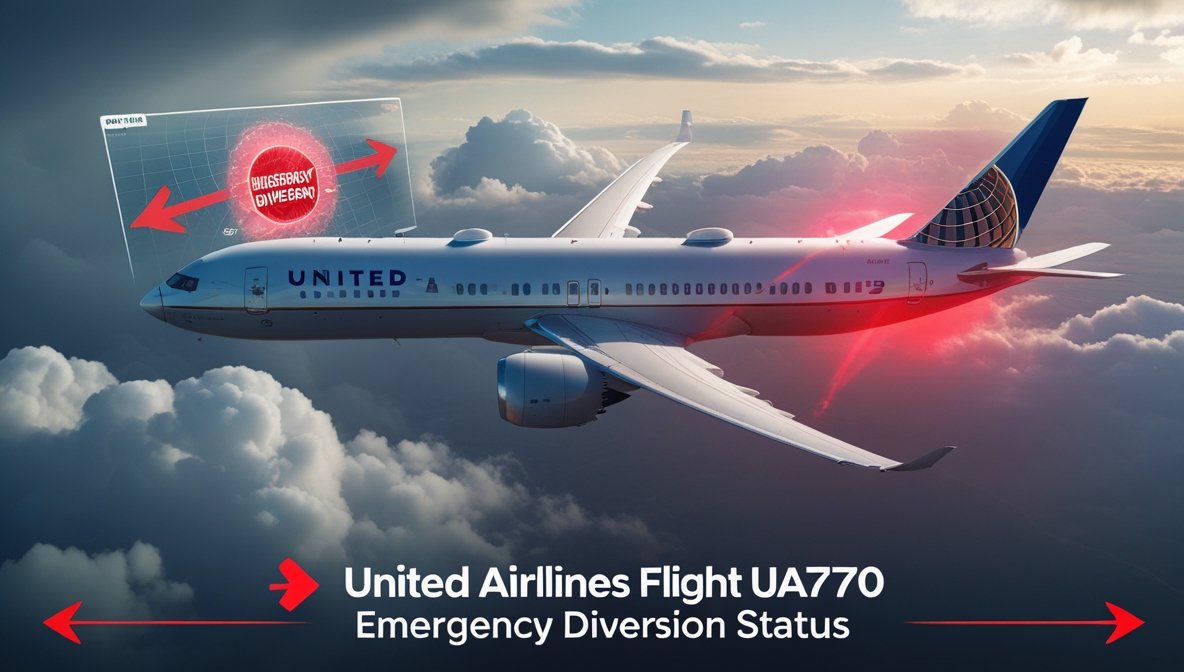United Airlines Flight UA770’s recent emergency diversion has prompted aviation experts to weigh in on what went right, what’s likely under review, and what lessons are emerging for airlines, regulators, and passengers. Based on the latest verified information and professional analysis, here’s a deeper look at what experts believe is happening, what’s been done, and what this means moving forward.
What Experts Are Saying: Key Technical Insights
Cabin Pressurization Anomaly
One of the leading expert opinions is that UA770’s diversion was triggered by a cabin pressurization anomaly. The pressurization system in modern aircraft maintains a safe and comfortable breathing environment at high altitudes, mimicking pressure found at lower elevations. When this system detects irregularities—whether in sensor data, outflow/inflow valves, or other control components—pilots are trained to treat the alert as a serious issue, even if it does not yet amount to full decompression. Experts note that early detection likely prevented more severe escalation.
From available reports, there was no deployment of oxygen masks, suggesting the situation was handled before reaching a critical threshold.
Pilot Decision-Making and Protocols
Experts emphasize that the crew’s response appears to follow established safety protocols: recognizing the warning, declaring an emergency (via transponder code “Squawk 7700”), coordinating with air traffic control, and selecting an appropriate alternate airport. These are standard but high-stakes decisions, especially on a transatlantic flight. The fact that the landing proceeded safely without injury suggests the flight crew acted promptly and professionally.
The Role of Aircraft Systems
Technical analysts point out that aircraft like the Boeing 787-9 (used on UA770) include redundant systems for environmental control and pressurization. The redundancy means even when one component (e.g. a valve or sensor) malfunctions, other systems can often maintain safety until the aircraft is on the ground. The presence of strong diagnostics and monitoring systems allows crews to detect unusual trends early, giving time for precautionary measures.
Read Also: Reliable Taxi Services From Train Stations To Towns
What Experts Believe Is Being Investigated
While many aspects seem clear, experts identify several areas that likely remain under detailed review as part of the ongoing investigation.
Specific Component Failure or False Alarm
- Sensor vs Mechanical Failure: Was the warning caused by a faulty sensor, an actual failure of a mechanical component (such as a pressure outflow valve), or some combination?
- False alarm possibility: Sometimes systems trigger alerts because data drifts outside expected norms due to calibration or monitoring system issues, even when the physical system is still critically okay.
Time Between Alert and Divert Decision
Another focus is how long elapsed between initial detection of the problem and when the flight crew decided to divert. Aviation experts say this interval is crucial: it impacts passenger safety, altitude change, fuel availability, and selection of nearest safe alternate airports. Precise logs (flight data recorders, cockpit voice recordings) will clarify this.
Passenger Communication
Experts often stress that even when technical issues are handled correctly, passengers’ perception depends heavily on how transparently and calmly information is communicated. Investigation will likely examine communication timing, clarity of announcements, and cabin crew behavior. These human factors are increasingly seen as core parts of safety—not just the mechanical ones.
Regulatory Compliance and Maintenance History
Authorities will examine UA770’s maintenance logs: Have there been previous signs in inspections? Were all required maintenance checks performed? Were any deferred maintenance issues relevant to pressurization? This review is standard when technical alerts lead to diversions. (infofortraveler.com)
What Worked Well: Approved by Experts
From what’s known, many experts say the UA770 incident demonstrates effective training, good technology, and strong safety culture. Here are what they view as strengths in this situation:
- Early detection allowed action before any real danger to passengers.
- Decision to divert was proactive rather than reactive. Choosing Heathrow (a well-equipped major hub) shows consideration of logistical and safety factors.
- Crew professionalism: Calm, clear communication with passengers tends to reduce panic, help compliance, and enable smoother handling of emergencies.
- Ground services preparedness: Emergency response teams and passenger support (rebooking, accommodations) appear to have been activated quickly. These are reminders of how much the behind-the-scenes preparation matters.
Potential Improvements: What Experts Recommend
While praising the response, experts also see areas for possible improvement. These suggestions may inform future policy, training, and engineering changes.
Better Predictive Maintenance
There is a trend toward more predictive systems—software that tracks sensor data over time and raises alerts before values cross thresholds. Enhancing these systems, especially for pressurization valves, sensors, and environmental control modules, could allow even earlier detection.
Enhanced Real-Time Monitoring and Alerts
Some experts call for more intuitive dashboards for crews so they can see clearly not only raw warnings but trends over time. This can help distinguish between transient sensor glitches and emerging mechanical issues.
Passenger-Centered Communication Training
While technical decisions are primary, how passengers are informed has strong effects on their stress and confidence. Experts suggest training modules that simulate mid-air alerts, with emphasis on communication skills (tone, content, frequency) and managing passenger anxiety.
Infrastructure at Alternate Airports
Even though Heathrow handled this well, experts note that some alternate airports may not be as ready in terms of emergency services, spare parts, or ground crews. Airlines might re-evaluate which alternates are selected, balancing proximity with available infrastructure.
What Passengers Should Take Away
Experts want passengers to understand several points based on UA770 and similar diversions:
- Diversion does not necessarily mean catastrophe. Often, diversions are precautionary. Many systems are behaving as designed to avoid escalation.
- Safety over schedule. Delays, reroutes, and extra waiting are unpleasant—but in such cases they are part of how airlines ensure everyone’s safety.
- Your rights matter. If diverted, you are generally entitled to support: accommodation, rebooking, meals. Keeping track of expenses and insisting politely but firmly on clarification helps.
- Crew are trained for this. The behavior of pilots, cabin staff, and ground personnel is shaped by extensive training for these emergency scenarios. The more calm and organized they appear, the more likely it is a sign that things are being handled properly.
Looking Ahead: What Expert Analyses Will Likely Reveal
Investigations often take weeks or months, and expert analyses are expected to yield more precise findings on:
- Exact part failure or root cause (which sensor or valve failed, or whether it was an alert without a mechanical fault).
- Timing gaps: how quickly after alert did the captain decide to divert, how long was the descent, and how quickly ground crews responded.
- Whether any policy or procedural changes will result, either for United Airlines, Boeing, or aviation regulators. This could include maintenance schedules, alert thresholds, checklists in flight manuals, or regulations requiring more frequent inspections of specific components.
- Broader learning for the industry, especially in pressurization safety and crisis communication.
Conclusion
From the expert perspectives available now, United Airlines Flight UA770’s emergency diversion appears to be an example of aviation safety systems working as intended. A technical anomaly triggered an alert, the crew responded appropriately, an emergency code was declared, and a diversion was executed smoothly. Passengers landed safely, and support efforts appear well managed.
While there remain open questions—about precisely what failed, how warnings evolved, and how quickly decisions were made—the general consensus is that the situation demonstrates strong safety practices. For airlines and regulators, UA770 may become a case study in how preparedness, communications, and technology converge to keep air travel safe.
If you like, I can monitor the official investigation updates and send you a summary once the full technical report is released.


